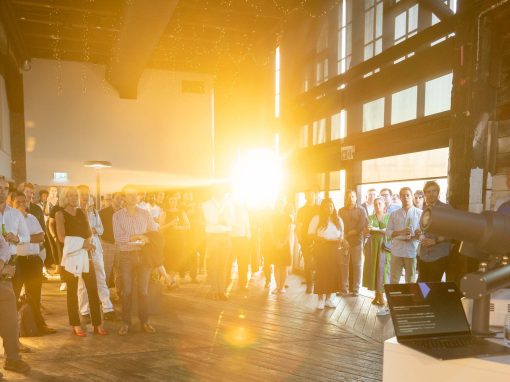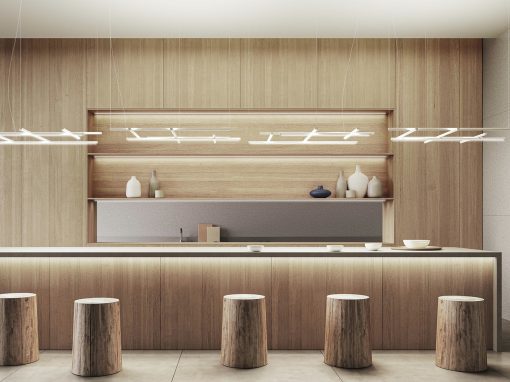Glass production
Glass refracts and amplifies light, and the two have been a complimentary pair for centuries. Because of its purity, glass is able to handle light in a purposeful yet visually stunning manner.

Molten glass
Glass is molten sand. Pure and natural, it can be returned to nature in its entirety or recycled as often as desired. We do not know exactly when glass was first made. The earliest finds date back to 7000 BC. We only know that the oldest production of glass was closely connected with pottery. It is a chance product that was created due to the heat in the kilns being too intense, causing the limey sand and soda to combine as a coloured glaze on the ceramics. Only in 1500 BC was it possible to produce glass without the ceramic base.
In BEGA’s glassworks in Limburg an der Lahn, they have mastered the art of creating high-quality glass from sand and various added aggregates. Their melting furnaces have a temperature of more than 1500 °C. The raw materials react during the melting process and liquefy into a molten substance. The liquid glass flows through a bottom channel, the throat, from the melting furnace into the working end, where it cools down to about 1200 °C and becomes viscous. Now the glassmakers can begin their work.
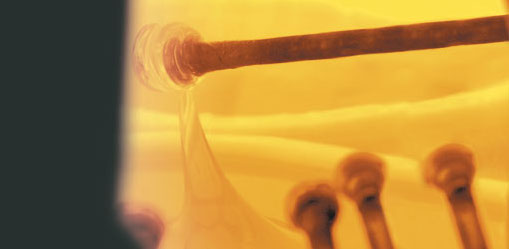
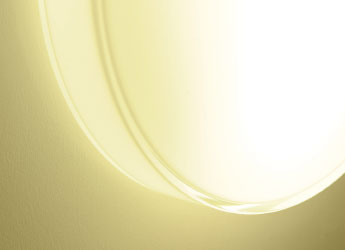
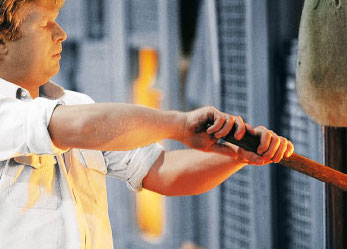
Three-ply opal glass
A speciality of BEGA’s glassworks is three-ply cased opal glass. The first stage in the production of this valuable glass involves removing the hot viscous glass from the crystal glass furnace. The post maker accurately plunges his blowing iron about 2 – 3 cm into the glass bath, and at the same time uses turning movements to wind a specific amount of the viscous glass around the nose of the blowing iron. The blowing iron is withdrawn from the glass bath, separating the first glass post from the glass bath. This somewhat shapeless glass mass is smoothed out around the axis of the blowing iron by turning and simultaneously pressing down with rotationally symmetrical movements on a roller plate to ensure that no uneven wall thicknesses are created during subsequent processing. To blow this massive glass mass, some air is pressed into the blowing iron and the post maker seals the end of the iron immediately with his thumb. The warmed air expands but is prevented from escaping, and presses into the soft workable glass. The post maker blows a small amount of air into the blowing iron with his mouth and the raw glass expands, reduces its wall thickness, cools down rapidly to about 600 °C and solidifies. During the cooling phase, the blowing iron with its attached glass post is carried to the adjacent opal glass tank. Here the “caser” takes over the blowing iron with the post. He very skilfully plunges the blowing iron with the post a few centimetres into the opal glass again. With constant rotations, he “winds” the opal glass around the crystal glass post and ensures that the glass is uniformly distributed. Rotating the glass at ever-increasing speed, he withdraws the blowing iron from the glass bath, tearing off the glass filament at the same time, and blocks the cased post in a wet wooden shaping block to form a uniformly round shape. During this phase, the glass passes through a temperature range of 840 °C and turns white. Carefully turning the blowing iron, the post carrier carries it back with the glass to the crystal glass furnace. After a brief cooling period, he can hand over the “semi-finished glass piece” to the glassmaker, who now has to take the final amount of glass, which in turn depends on the required shape of the glass, from the tank. This can range from 2 -15 kg of glass, depending on the size of the glass shape. Careful attention must be paid to the specified weight and the distribution of the glass on the post. Too much glass causes problems in wall thickness, too little glass has a detrimental effect on the stability of the glass.

Glass shaping
Square or asymmetrical shapes require extremely high precision when the glass is withdrawn. Once removed, the glass post is blocked again in a much larger wet shaping block, evened out and “adjusted” accordingly until it has reached its final shape. This is the moment where skilful craftsmanship and maximum concentration are vital since this process has to be completed in just a few seconds. The hot, still workable glass is set in an iron mould which is closed and bolted by the mould operating assistant. At the same time, the glassmaker blows the glass, either with his breath or with compressed air. When the glass then touches the walls of the cast-iron mould, it cools down very quickly to about 600 °C and solidifies. The mould is unbolted and the glass removed while it is still attached to the blowing iron. To separate the glass from the blowing iron, a few drops of water are trickled onto the glass/metal joint using a wooden stick. The water hisses at the place where the drops fall and chills the hot glass. Small cracks suddenly appear on the glass surface. These are sufficient to separate the glass accurately from the blowing iron in this area with one gentle tap. This concludes the manufacturing and forming process of the raw glass.


